1. Introduction
More than 676 million people have been infected with severe acute respiratory syndrome coronavirus 2 (SARS-CoV-2), and 6.8 million people have died from the disease worldwide (as of March 13, 2023).[1] In Africa, more than 12 million people have been infected with COVID-19 and more than 250,000 mortalities have been reported (Africa CDC COVID-19 Dashboard, March 13, 2023).[2] Consequently, there has been a growing burden on existing health systems relative to the number of cases. Several vaccines against COVID-19 have been developed and 11.7 billion doses have already been administered in a bid to quell the growing numbers of COVID-19 cases (COVID19 map - Johns Hopkins Coronavirus Resource Center, August 22, 2022).[1] Failure of vaccine uptake however continually propagates the growing prevalence and worse prognosis of the disease, especially in countries across Africa, contributing to ∼2.4% of COVID-19 associated mortality rates in the continent.[3] Low and middle-income countries remain largely affected by higher rates of hesitancy owing to several factors such as a lack of knowledge on vaccine efficacy as well as other socio-cultural and historical dynamics.[3]
Historically, vaccines have been proven to be very successful and cost-effective tools for preventing diseases.[4] Herd immunity can be achieved when enough people receive an effective vaccine which also protects those who are susceptible to the virus.[5] As expected, the research focus on COVID-19 has shifted from treatment of the disease to the role of vaccines and implications brought about by the budding rates of vaccine hesitancy. However, these studies have mainly been conducted in developed countries such as the United States and European countries, with relatively few studies focusing on developing countries such as African nations.[6] The few existing country-specific studies on vaccine hesitancy in Africa are limited by their focus on specific population groups such as health care workers or medical students. Subsequently, the true prevalence of vaccine hesitancy in Africa remains relatively unknown.
Hence this systematic review and meta-analysis was conducted in order to assess the pooled vaccine acceptance rates and factors influencing vaccine acceptance. We expect that our meta-analysis can provide clinicians with a thorough understanding of vaccine rejection rates in African countries and the influential factors.
2. Materials and methods
We followed the guideline of the Preferred Reporting Items for Systematic Reviews and Meta-Analyses (PRISMA) checklist for this systematic review (Supplementary Table S1).[7] Two investigators (Y.K. and W.W.) searched the literature in PubMed/Medline to find the original studies that conducted surveys of COVID-19 vaccine hesitancy in Africa. The search terms were “(covid-19 vaccine) AND (hesitancy OR refusal OR willingness) AND survey”, and the date of the last search was 19 December 2021. If there were any discrepancy for the inclusion or exclusion of the study, the two investigators (Y.K. and W.W.) discussed and resolved it. The full method of screening papers is presented in Fig. 1.
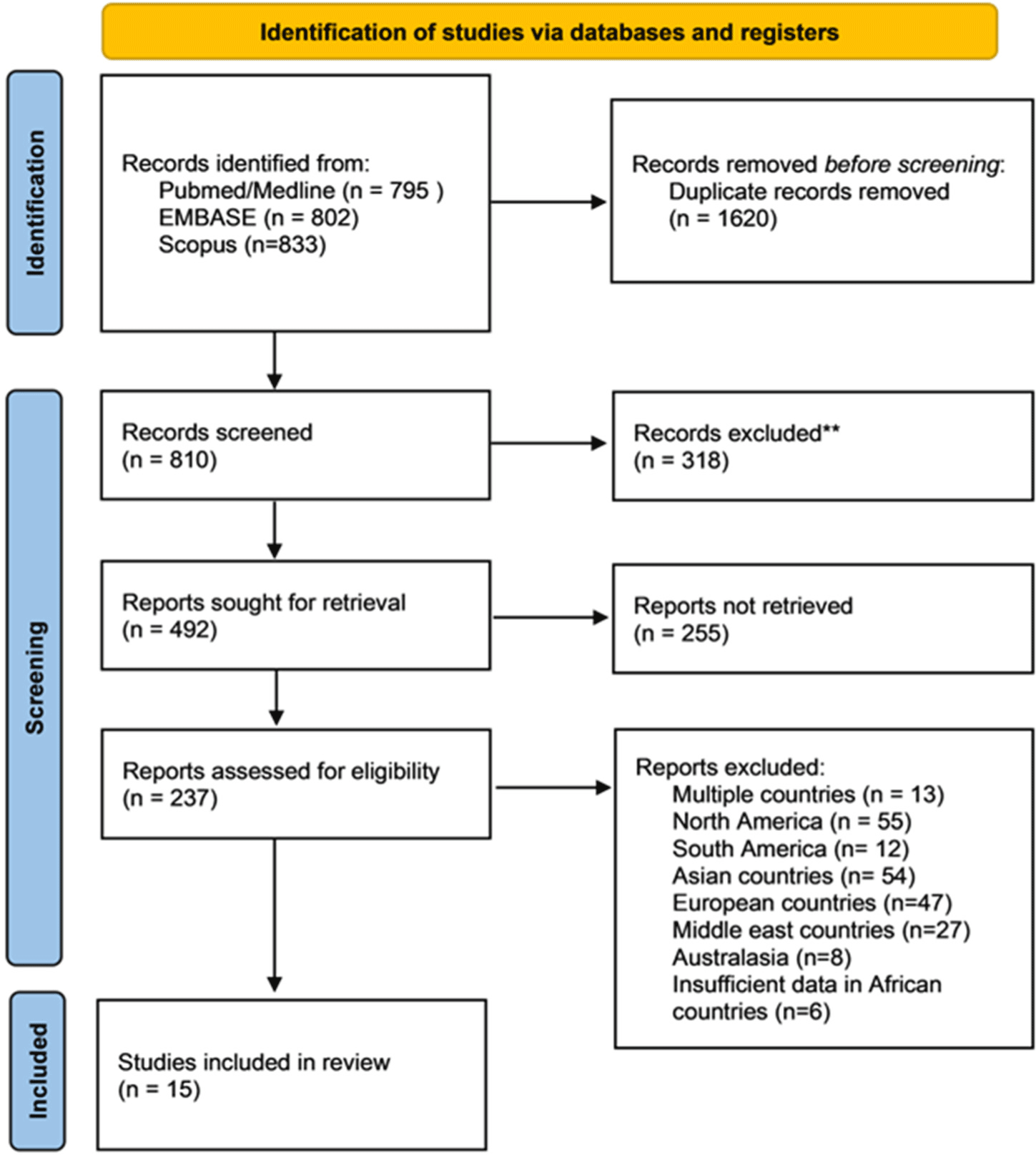
The eligibility criteria for inclusion were: (1) survey was conducted inof the general population; (2) main goal of the paper was to find the hesitancy/acceptance rate of COVID-19 vaccine; (3) survey was conducted in Africa; and (4) publication language was English. The exclusion criteria were: (1) survey was conducted with healthcare workers; and (2) survey was conducted with specific populations such as military workers, caregivers, and young or old populations. Our initial search yielded 795 results, but we eventually included 15 studies that met our inclusion criteria.
For each eligible study, we extracted the following data: country/countries where the survey was conducted, author, participants, survey methods, period of survey, demographic data, total number of respondents, COVID-19 vaccine hesitancy/acceptance rate, and predictive factors related to vaccine acceptance rate.
We also searched the actual vaccination rates in the country at the time the study was conducted, and 3 and 6 months after that using Our World in Data – COVID vaccinations.[8]
The data for each study are presented in Table 1. To estimate the relationship between vaccine acceptance and each variable, we used an estimation of 95% confidence interval (CI) using random-effect models (DerSimonian and Laird, 2015; Lau et al., 1997). The random-effects model provides the weighted average of the effect sizes of a group of studies with the assumption that each study supplies information about a different effect size (Ioannidis et al., 2011). We evaluated the between-study heterogeneity using the I2 metric of inconsistency. I2 is the ratio of the between-study variance over the sum of the within-study and between-study variances, and it ranginges from 0–100%. I2 values over 50% usually represent significant heterogeneity (Higgins et al., 2003). Publication bias was not assessed because studies included in the proportion meta-analyses were non-comparable. All analyses were conducted using R version 4.1.0 (R Foundation for Statistical Computing, Vienna, Austria).[9]
3. Results
A total of 15 studies met the inclusion criteria and were employed in the present systematic review and meta-analyses as outlined in the PRISMA flow chart (Fig. 1). Fifteen studies investigated the acceptance rate of SARS-CoV-2 vaccines among people in African countries, with the demographic information for each study is provided in Table 1.[10]-[24]
Fifteen studies, in which the number of investigated populations varied from 551 to 10,702, were conducted in several African countries, including Ghana, Nigeria, Morocco, Egypt, Mozambique, Zimbabwe, Somalia, and Ethiopia. Most of the surveys were conducted online (survey tools, Microsoft forms, REDCap software, Google forms, or independent programs; n=10) or by phone (n=4). Three studies were conducted in the second half of 2020, and 12 studies were conducted in the first half of 2021.
In some cases, actual vaccination rates data by country for the desired date (at survey, 3,6 months after) were not available. In this case, we used data from the closest date with data after that date. If there was a difference within one month, it is marked as *, and if there was a difference of more than one month, it is marked as **.
The pooled SARS-CoV-2 vaccination acceptance rate by studies based on countries are shown in Fig. 2. In the overall study, the SARS-CoV-2 vaccine acceptance was 71% (95% CI 64-77).
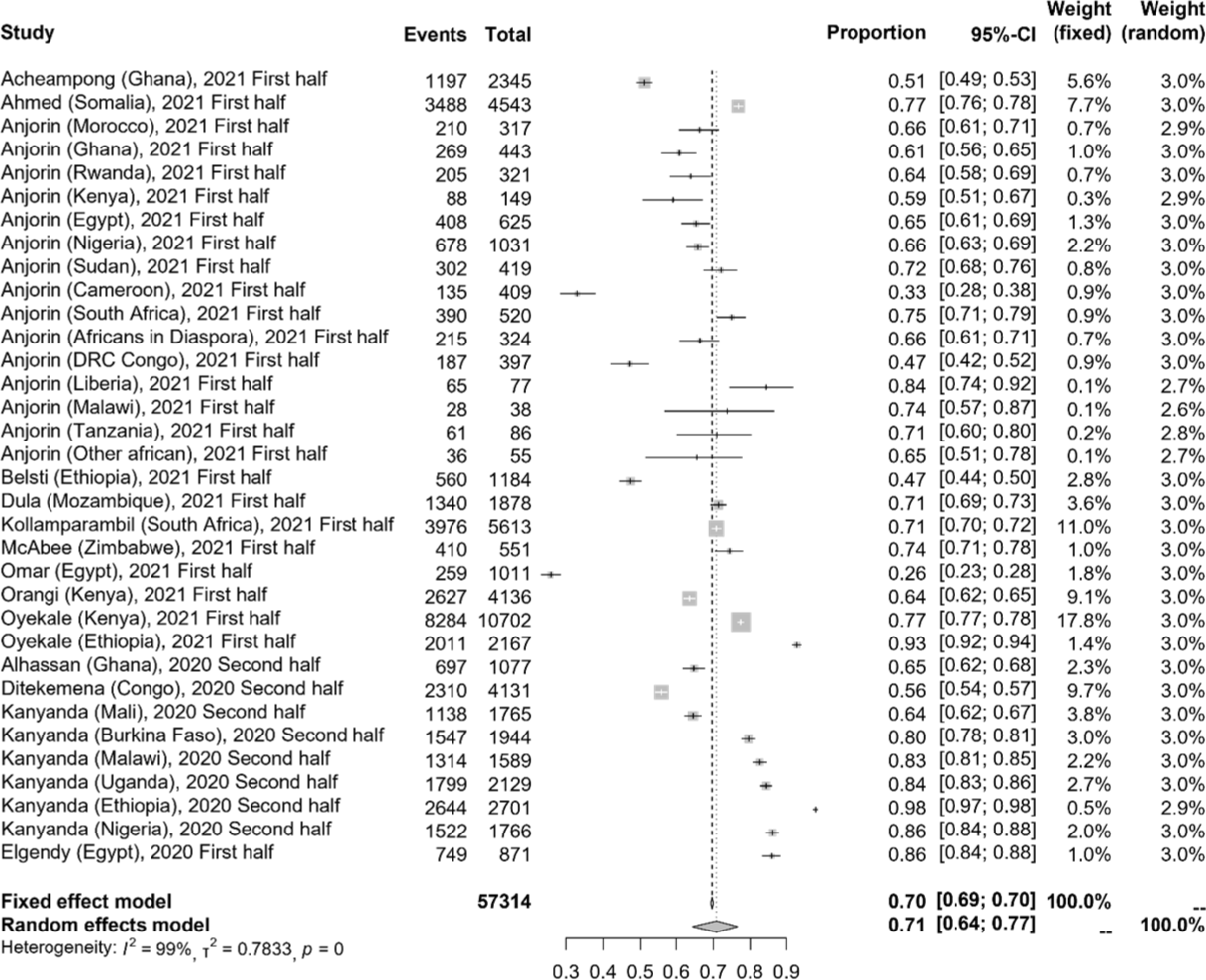
A meta-analysis was conducted based on the study period, residential area, gender, language, location, and Gross Domestic Product. The results of the meta-analysis are shown in Fig. 3-5.
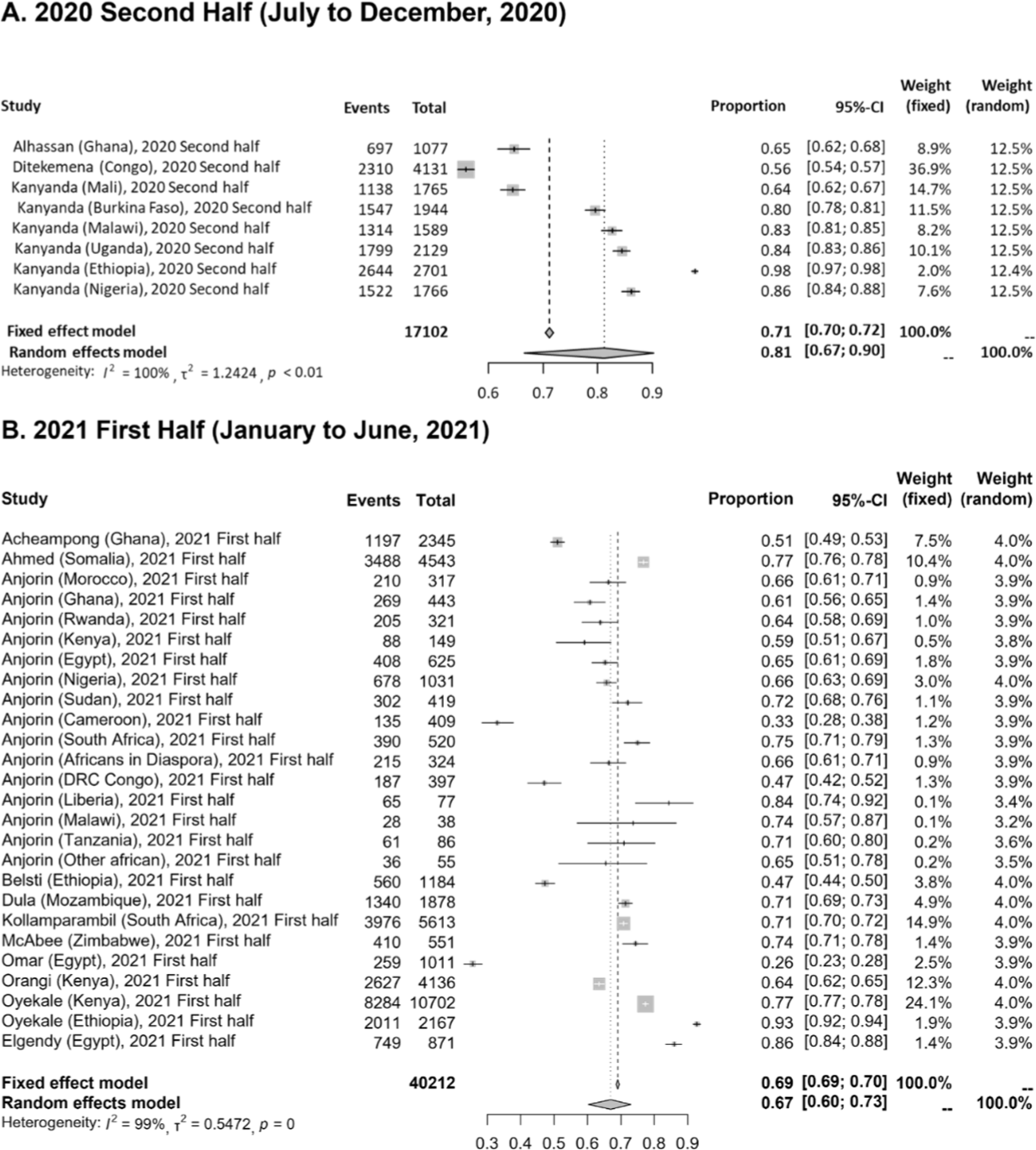
First, the vaccine acceptance rate according to the study period was 81(95% CI 67-90) in the second half of 2020, and 67% (95% CI 60-73) in the first half of 2021 (Fig. 3). As time passed, the vaccine acceptance rate was found to decrease.
Second, the vaccine acceptance rate according to residential area was 72% (95% CI 52-86) in rural areas (studies with urban participants < 60%) and 82% (95% CI 66-91) in urban areas (Fig. 4).
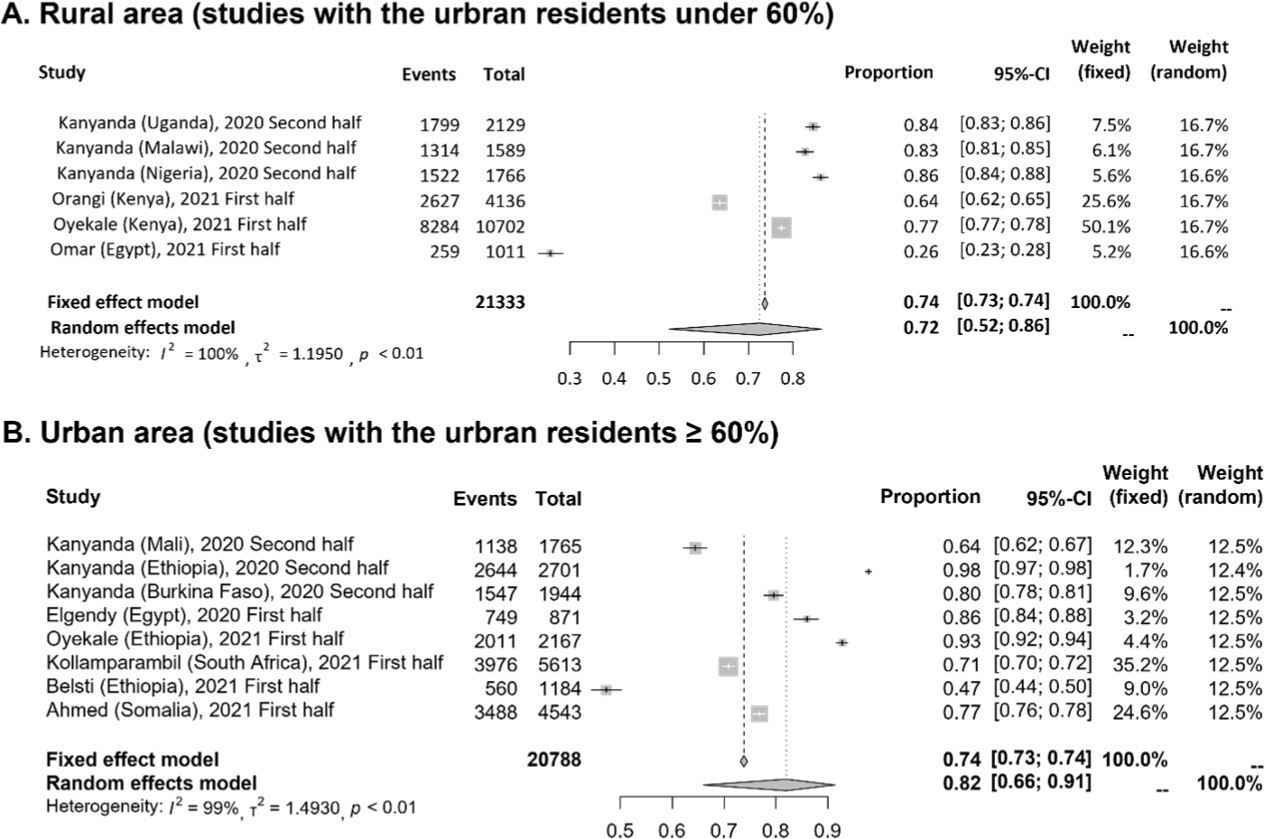
Third, the vaccination rates according to region were 60% (95% CI 41-76) in West African countries, 72% (95% CI 70-74) in Southern African countries, 52% (95% CI 26-77) in Northern African countries, and 72% (95% CI 60-81) in Eastern African countries (Fig. 5).
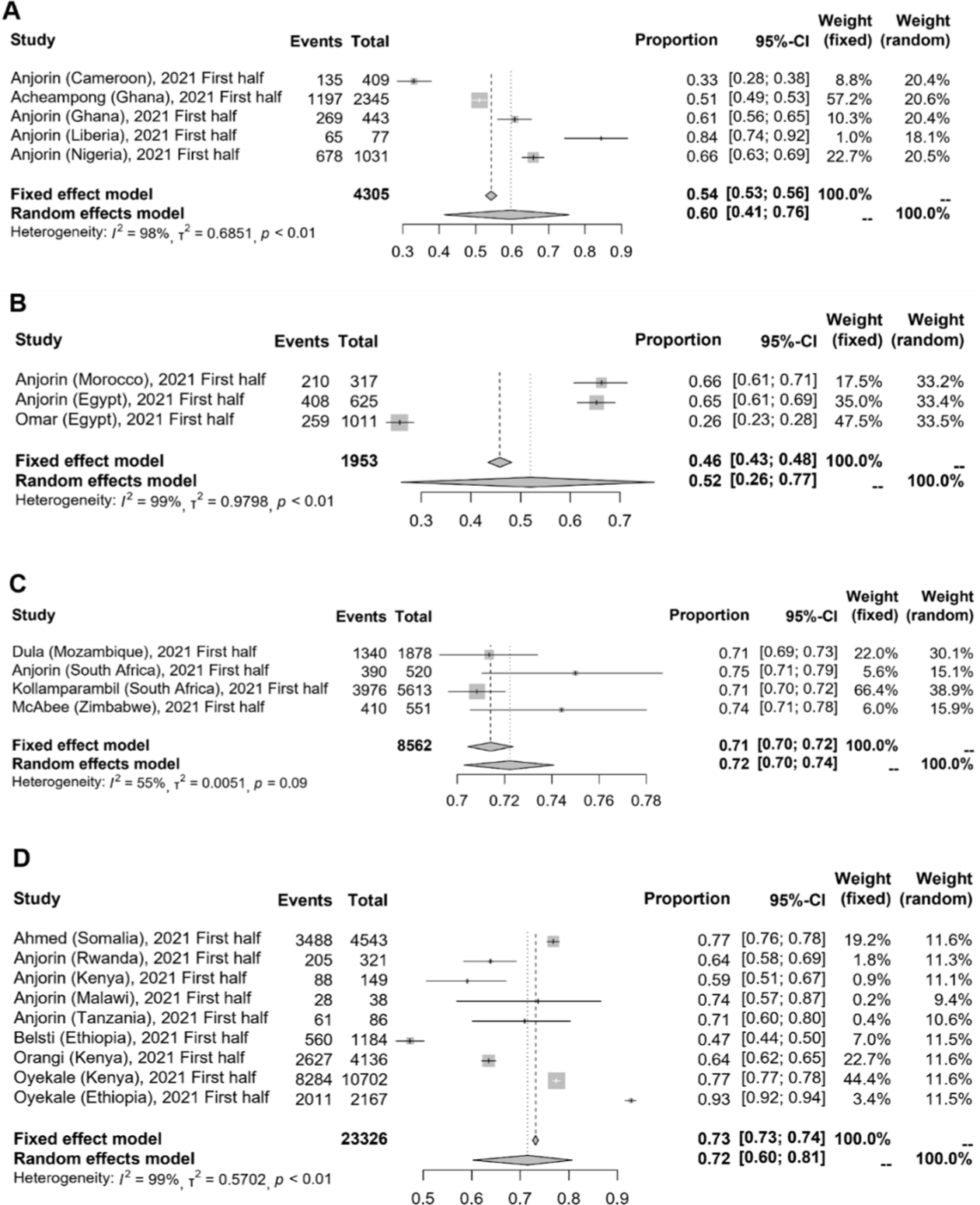
The actual vaccination rate by country varied from 0.00 to 9.80% at the time of the survey and 0.09 to 50.98% six months after the survey. However, this was not significantly related to the vaccine acceptance rate investigated in the study.
Factors related to vaccine hesitancy from studies are shown in Table 2. Factors analyzed in two or more studies are summarized in Table 2. Factors such as older age, male sex, wealth, higher awareness of COVID-19 related information, currently working, working in health-related job, suffering chronic disease, previously tested for or COVID-19 were mainly identified as factors showing a more acceptive attitude toward vaccination. On the other hand, lower education was identified as a hesitance factor for vaccination.
4. Discussion
With the prolongation of the COVID-19 pandemic, the importance of vaccination cannot be understated.[25] In order to increase vaccination rates in any country, it is important to first analyse the vaccination hesitancy rates and identify the factors that propagate rejection of the vaccine. A proper understanding of this helps tailor appropriate strategies to avert the budding rate of vaccine hesitancy.
This study examined COVID-19 vaccine acceptance among African countries. We found that approximately 7 out of 10 (71%) Africans wanted to be vaccinated. This is relatively lower than around the 80% that was observed in the American population according to a 2021 randomized controlled trial, conducted in the United States.[26] Another article published in December 2020 however stated that vaccine acceptance rate in the US was as low as 56.9%. [27] The difference between the two studies seems to have been caused by the faction of participants who were unsure rather than hesitant to receive the vaccine. However, unlike America, where widespread studies and education were conducted on the role of vaccines, the lower rates observed of vaccine hesitancy in Africa have been attributed to a lack of knowledge on vaccine efficacy, socio-cultural and historical aspects. [3]
We also found that vaccine acceptability was also influenced by several other factors. First, depending on the study period, it was possible to see a trend of decreasing vaccine acceptance over time, from 81% in the second half of 2020 to 67% in the first half of 2021. The same trend was seen in a meta-analysis of 28 representative samples from 13 countries (UK, North America, France, Australia, China, Denmark, Germany, Italy, Ireland, Netherlands, Poland and Portugal) on COVID-19 vaccine hesitation.[28] This phenomenon was also seen in vaccines other than the coronavirus vaccine. In 2009, a study of the H1N1 influenza vaccine in France showed a sharp increase in negative attitudes toward the vaccine over time.[29] This can be due to the decrease in people’s fear of disease as a result of increasing information on the new disease, and more information on the side effects of vaccines.
Second, the vaccine acceptance rate in rural areas was 72%, lower than in urban areas (82%). This is in contrast to a study conducted in the United States in 2021, which found that rural people (16.3%) were less likely to reject COVID-19 vaccines as compared to urban people (19.7%).[30] The difference between the two studies may be that there are people who neither accept nor reject vaccination. Alternatively, as shown in a study conducted in the United States, people living in rural areas may be less likely to participate in health promoting behaviors[31], which leads to less interest in the vaccine per se. This may be the reason of low rates for acceptance.
Third, the vaccine acceptance rate in Northern African countries was 52%, relatively lower than Western African countries (60%) or Southern African and Eastern African countries (72%). These findings could have been influenced by the number of studies conducted in each of the regions with a possibility of regional underreporting of vaccine hesitancy. Hence, a need for more research on vaccine hesitancy, especially in Northern African countries, are warranted. We also found differences in vaccine acceptance rates and some socio-demographic characteristics. Older age, male, wealth, health-related workers, and chronic medical conditions were mainly identified as factors contributing to a receptive attitude toward vaccination. Interestingly, low educational attainment was identified as a factor related with hesitancy to receive the vaccine. Among these factors, the low acceptance rate of women’s vaccines tended to be consistent with previous studies.[32]-[34] Overall, it is thought that people who are interested in health activities and those who will suffer greatly from the COVID-19 are favorable to vaccination, and those who are worried about vaccines tend to refuse vaccination.
There are several articles on vaccine acceptance rates in developed countries such as European countries and the USA, but insufficient amounts of studies have been done on African countries. As the COVID-19 situation is being prolonged, vaccinations in developing countries such as African nations are considered important.
We applied a meta-analysis of studies conducted in African countries.
To our knowledge, this study is the first attempt to meta-analyse recent vaccine rejection related studies conducted in African countries and to demonstrate trends and associated factors. Therefore, this meta-analysis will provide a more systematic understanding of vaccine acceptance rate, rejection factors, and the appropriate strategy in African countries.
This study was also the first to investigate how much the previously investigated vaccine acceptance rate is related to the actual vaccination rate. It has the advantage of being able to discover how much the surveyed vaccine acceptance rate is related to the actual vaccination rate.
Several studies have reported that age, gender, and residential area are related to the vaccine rejection rate.[28],[35] Also, as a result of meta-analysis, sex and residential area were found to be related. Urban areas had higher vaccine acceptance rates than rural areas, and male-dominated areas had higher vaccine acceptance rates than female-dominated areas. In addition, as a result of analysis according to the study period, it was found that the vaccine acceptance rate decreased over time. This can also be considered to be an advantage of the meta-analysis because it is a factor that cannot be known by individual surveys.
Many studies had limits of analysing only the acceptance rate of vaccines. However, even including the fact that our study used meta-analysis further investigate and compare the actual vaccination rate, no significant correlation was found. We believe that the actual vaccination rate tends to be determined by other external factors rather than individual opinions on vaccines in the past.
There are some limitations to this study. First, the included studies have generally mentioned vaccine acceptance rates, but there have been some discrepancies in defining vaccine acceptance rates. Each study showed its own definitions or various expressions such as vaccine acceptance rate, vaccine rejection rate, vaccine hesitancy, and vaccine willingness rate.
Second, the heterogeneity between results was significant, and careful interpretation is required depending on different environments. This heterogeneity may be due to differences between study designs, cultural differences, vaccination local policies, or studies of other unidentified variables. In addition, there is a possibility that there will be a double aggregated case among the included studies.
5. Conclusion
COVID-19 vaccine acceptance rates demonstrated shifts and was affected by several factors. The rates decreased over time, were lower in rural (vs. urban) settings, and were relatively low in Northern and West African countries (vs. Southern and East African countries). We also found differences in vaccine acceptance rates by some socio-demographic characteristics. Targeting these characteristics, devising strategies to improve vaccine uptake in Africa could help improve vaccination rates.
